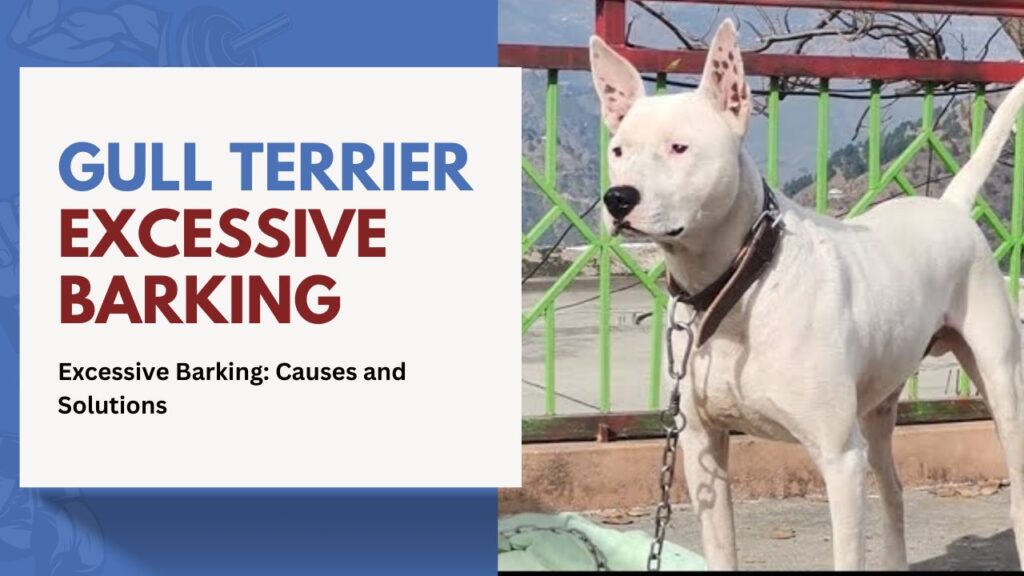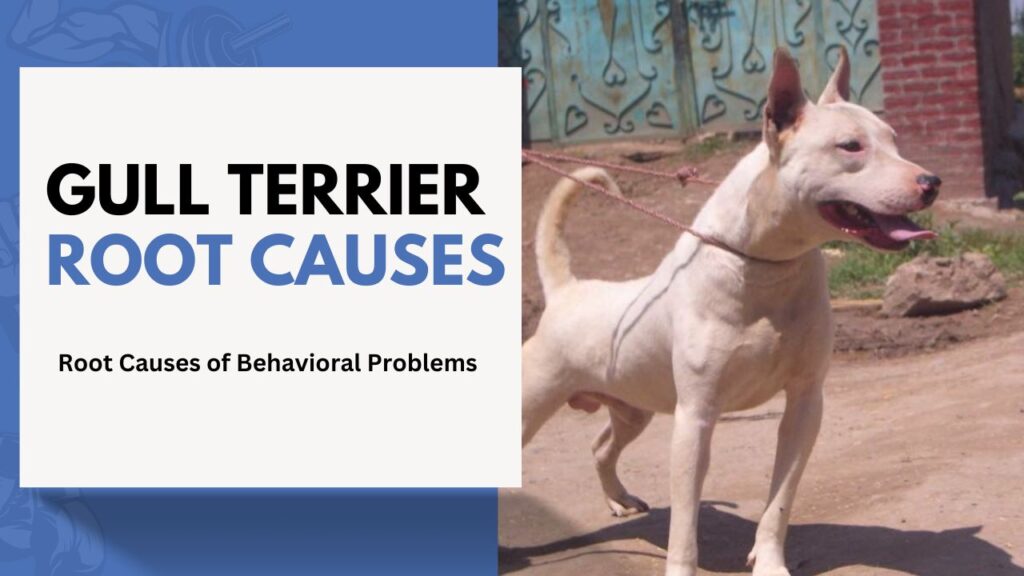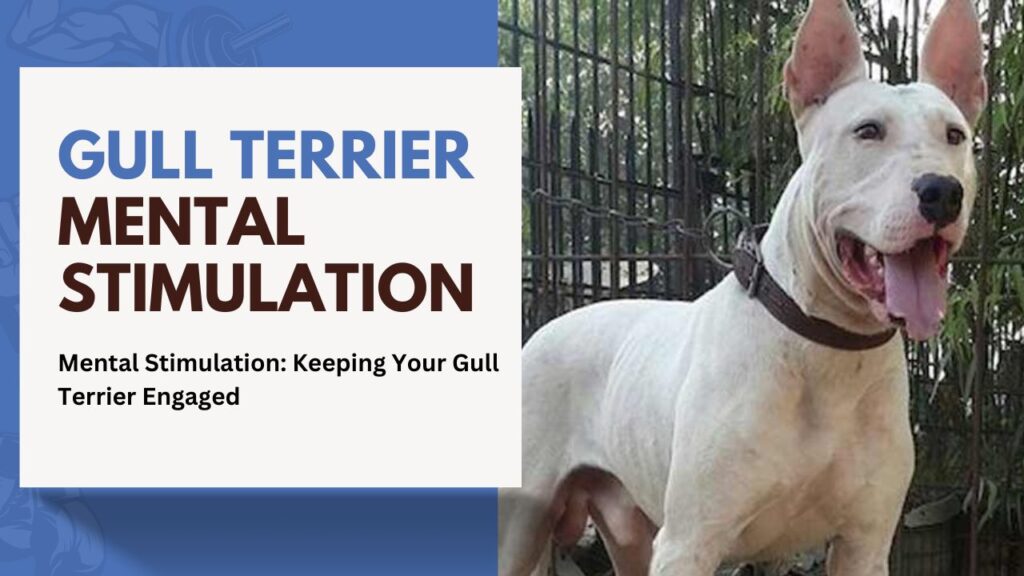Behavioral Issues in Gull Terriers
Last Updated: March 28, 2024, Written by: Faisal Amin
Gull Terriers are known for their spirited and energetic temperament, making them beloved pets for those who appreciate the breed’s unique characteristics. However, like all dogs, they can exhibit behavioral issues that challenge even the most experienced dog owners. Addressing these behaviors is not just about improving the quality of life for you and your…
Gull Terriers are known for their spirited and energetic temperament, making them beloved pets for those who appreciate the breed’s unique characteristics. However, like all dogs, they can exhibit behavioral issues that challenge even the most experienced dog owners. Addressing these behaviors is not just about improving the quality of life for you and your pet; it’s about understanding the needs and instincts of your Gull Terrier and guiding them to fit into the human world more harmoniously.
Behavioral issues, if left unaddressed, can lead to stress, anxiety, and even danger for the dog and others. This guide delves into common behavioral issues seen in Gull Terriers, exploring their causes and providing practical solutions for correction.
Common Behavioral Issues in Gull Terriers
Common issues include aggression, which can manifest in guarding food or being overly territorial, leading to potential conflicts with other dogs or humans. Excessive barking is another issue, often resulting from boredom, anxiety, or the desire for attention, which can disrupt household peace. Destructive chewing, especially in puppies, can be a sign of teething discomfort or a lack of mental and physical stimulation. Understanding these behaviors is crucial for Gull Terrier owners, as it allows them to provide appropriate training and enrichment to address and mitigate these issues effectively.
Aggression: Types and Triggers
Aggression in Gull Terriers, as in any breed, can stem from various triggers and manifest in different forms. Understanding the types of aggression and what provokes these behaviors is the first step in addressing and correcting them. Whether it’s food aggression, territorial aggression, or another form, identifying the root cause is crucial for effective management and correction. Early intervention is key to preventing aggression from becoming a more significant issue.
Food Aggression:
This behavior is characterized by growling, snapping, or biting when their food is approached or threatened. It often stems from fear of having their food taken away or the need to assert dominance over resources. To correct food aggression, start by hand-feeding your Gull Terrier to build trust, and gradually introduce commands like “leave it” to teach them that relinquishing food leads to rewards.
Territorial Aggression:
Territorial aggression is exhibited when a Gull Terrier feels their space is invaded, leading to barking, lunging, or biting. This can occur at home, on walks, or in any space the dog claims as their own. Correcting this behavior involves establishing yourself as the pack leader, using positive reinforcement to reward calm behavior, and desensitization exercises to reduce their sensitivity to perceived threats.
Excessive Barking: Causes and Solutions

Excessive barking in Gull Terriers can be frustrating and is often a symptom of underlying issues such as attention-seeking behavior or anxiety. Identifying why your Gull Terrier is barking excessively is crucial to finding the right solution and restoring peace.
Attention-Seeking Behavior:
Some Gull Terriers bark excessively to gain attention or response from their owners. Ignoring the barking and rewarding quiet behavior with attention or treats can help teach your dog that silence, not barking, is the correct way to get what they want.
Boredom or Anxiety:
Boredom or anxiety can also lead to excessive barking as a form of self-soothing or calling for attention. Providing ample physical and mental stimulation through exercise, playtime, and training can help mitigate these feelings and reduce unwanted barking.
“Addressing a Gull Terrier’s behavioral issues is like untangling a knotted rope—patience and steady hands reveal the strength and beauty that was there all along. It’s a journey of understanding, not just correction, that strengthens the bond between you and your spirited companion.”
Destructive Chewing: The Underlying Reasons
Destructive chewing is a common issue that can be driven by various factors, including teething in puppies and lack of mental stimulation. Addressing the root cause is essential for correcting this behavior.
Teething in Puppies:
Young Gull Terriers may chew destructively as they navigate the discomfort of teething. Providing appropriate chew toys and gently discouraging chewing on inappropriate items can help steer this natural behavior in a positive direction.
Lack of Mental Stimulation:
Without adequate mental stimulation, a Gull Terrier may turn to chewing as a form of entertainment and relief from boredom. Engaging in regular, interactive play sessions, incorporating puzzle toys into their routine, and ensuring they have a variety of appropriate items to chew on can help satisfy their need for mental engagement and prevent destructive chewing.
Root Causes of Behavioral Problems

The root causes of behavioral problems in Gull Terriers is essential for any pet owner aiming for a harmonious relationship with their furry companion. These issues often stem from a lack of proper socialization, inadequate or inconsistent training, and sometimes, underlying medical conditions that may manifest as behavioral changes. Separation anxiety is another significant factor, characterized by distress and destructive behaviors when left alone. Identifying these root causes allows for targeted interventions that can drastically improve not only the behavior of Gull Terriers but also their overall well-being and happiness. Recognizing the signs early and taking action can prevent these behaviors from becoming ingrained, making correction much easier.
Lack of Socialization
Lack of socialization can lead to fearfulness, aggression, and difficulty adapting to new environments or situations. Proper socialization involves exposing your Gull Terrier to a variety of people, animals, and environments in a controlled and positive manner. It’s essential for helping them develop into well-adjusted adults.
Inadequate Training
Inadequate training can lead to confusion and misbehavior in Gull Terriers, stemming from unclear expectations or inconsistent communication.
- Inconsistent Commands: Using different words for the same command or changing rules can confuse your dog. Consistency is key to effective communication.
- Negative Reinforcement: Relying on punishment can lead to fear or aggression. Positive reinforcement is more effective and builds a stronger bond.
- Lack of Regular Practice: Skills fade without practice. Regular training sessions help reinforce desired behaviors.
- Misunderstanding Dog’s Needs: Misinterpreting what a dog needs can lead to ineffective training. Understanding your dog’s perspective is crucial.
Separation Anxiety
Separation anxiety is a distressing condition for dogs, manifesting in destructive behavior, excessive barking, and other stress-related behaviors when left alone.
- Signs and Symptoms: Destructiveness, incessant barking or howling, urination or defecation indoors, and signs of stress when you prepare to leave.
- Triggers: Sudden changes in routine, loss of a family member, or moving to a new home can trigger anxiety.
- Duration: Issues often occur within the first 20-30 minutes after the owner leaves.
- Physical Symptoms: Drooling, pacing, and attempting to escape are common physical signs of separation anxiety.
Effective Training Techniques
Implementing effective training techniques is key to addressing and correcting behavioral issues in Gull Terriers. Positive reinforcement, which rewards desired behaviors with treats, praise, or play, encourages repetition of those behaviors and strengthens the bond between pet and owner. Techniques such as clicker training can be particularly effective, marking the exact moment a desired behavior is performed and immediately rewarding it. Setting clear boundaries and maintaining consistency in commands and rules helps dogs understand expectations, providing them with the structure they need.
Positive Reinforcement: The Basics
Positive reinforcement rewards desired behaviors, encouraging your Gull Terrier to repeat them. It’s an effective approach that strengthens your bond.
- Reward-Based Training: Involves giving treats, praise, or playtime as rewards for correct behavior. It’s effective for teaching new commands and discouraging negative behavior.
- Clicker Training: Uses a clicker to mark the desired behavior at the exact moment it occurs, followed by a reward. It’s precise and helps the dog associate the behavior with positive outcomes.
- Consistency: Applying the same rules and rewards consistently helps the dog understand what is expected.
- Patience: Positive reinforcement requires patience. Results may not be immediate, but consistent effort will yield long-term benefits.
Setting Boundaries: Establishing Rules and Limits
Setting clear boundaries is crucial for preventing behavioral issues and ensuring your Gull Terrier understands their limits within the household.
- The Importance of Consistency: Everyone in the household must enforce the same rules consistently. Mixed signals can confuse your dog and undermine training efforts.
- Using Time-Outs Effectively: Time-outs can be a useful tool for discouraging undesirable behavior. They remove the dog from the situation and give them time to calm down.
- Clear Boundaries: Define which areas are off-limits and what behaviors are unacceptable. Consistently enforcing these rules teaches your dog how to behave.
- Rewards for Compliance: Rewarding your Gull Terrier for respecting boundaries reinforces their good behavior and encourages them to continue following the rules.
Professional Help: When to Seek a Trainer or Behaviorist
Sometimes, despite your best efforts, you might need professional help to address your Gull Terrier’s behavioral issues. Knowing when and how to seek this help can make a significant difference.
- Identifying the Need for Professional Assistance: If your dog’s behavior is not improving or is worsening despite your efforts, it’s time to consider professional help.
- Choosing the Right Professional: Look for a trainer or behaviorist with experience in dealing with similar issues and a positive reinforcement-based approach.
- Certifications and Recommendations: Check for certifications and ask for recommendations from other pet owners or your veterinarian.
- Commitment to the Process: Working with a professional requires commitment. Be prepared to actively participate in the training process.
Preventive Measures and Daily Routines
Preventive measures and establishing daily routines are pivotal strategies in managing and correcting behavioral issues in Gull Terriers. These practices not only help in averting potential behavioral problems but also contribute to a well-adjusted and happy dog. Exercise and mental stimulation play a crucial role in preventing issues like aggression, excessive barking, and destructive chewing. Consistent schedules, including regular feeding times and structured play and rest periods, offer the stability that can significantly impact your dog’s behavior positively. By understanding and applying these strategies, owners can create a nurturing environment that encourages good behavior in their Gull Terriers.
The Role of Exercise in Preventing Behavioral Issues
Regular exercise is essential for Gull Terriers, not only for their physical health but also for maintaining balanced behavior. A well-exercised dog is generally calmer and less prone to engaging in problem behaviors such as excessive barking or chewing.
Daily Exercise Guidelines:
Gull Terriers should engage in at least an hour of physical activity daily, which can be split into two or more sessions to keep them stimulated throughout the day. Activities should vary to keep them interesting and engaging for the dog, ranging from walks and runs to games that challenge them physically.
Interactive Play and Activities:
Interactive play sessions, such as fetch or tug-of-war, provide both physical exercise and mental stimulation. These activities also strengthen the bond between the dog and owner, establishing a foundation of trust and understanding that is crucial for behavioral training.
Mental Stimulation: Keeping Your Gull Terrier Engaged

Mental stimulation is as important as physical exercise in preventing behavioral issues. Engaging your Gull Terrier’s mind can prevent boredom, a common cause of destructive behaviors.
Puzzle Toys and Games:
Introducing puzzle toys that reward problem-solving with treats can keep your Gull Terrier engaged and mentally stimulated. These toys encourage natural problem-solving abilities, providing a healthy outlet for their energy.
Training Sessions as Mental Exercise:
Regular training sessions, focusing on new tricks or reinforcing existing commands, serve as excellent mental exercises. They not only keep your Gull Terrier mentally sharp but also reinforce desirable behaviors, making them an integral part of preventing behavioral issues.
Consistent Schedules: The Impact on Behavior
Consistency in daily routines provides a sense of security and predictability for Gull Terriers, contributing to their emotional well-being and reducing anxiety-related behaviors.
Regular Feeding Times:
Adhering to a strict feeding schedule helps prevent food aggression and anxiety around meal times. It establishes a routine that your Gull Terrier can rely on, reducing stress and promoting calm behavior.
Structured Play and Rest Periods:
Balancing structured playtimes with rest periods throughout the day helps manage your Gull Terrier’s energy levels. Knowing when to expect play and rest can reduce anxiety and prevent erratic behaviors, creating a calm and stable environment.
Advanced Behavioral Modification Techniques
For Gull Terriers exhibiting more challenging behaviors, advanced behavioral modification techniques, such as desensitization, counterconditioning, and the use of specific behavior modification tools, can be highly effective.
Desensitization and Counterconditioning
These techniques are powerful in addressing fear-based behaviors, such as aggression or phobias, by gradually exposing the dog to the source of their fear in a controlled manner.
Steps for Successful Desensitization:
Start by identifying the trigger for your Gull Terrier’s fear or aggression. Gradually expose them to this trigger at a distance or intensity that does not provoke a full-blown reaction, slowly decreasing the distance or increasing the intensity over time.
Implementing Counterconditioning:
Alongside desensitization, counterconditioning involves associating the fear-inducing stimulus with positive outcomes. For instance, treating your Gull Terrier when they remain calm in the presence of the trigger can change their emotional response over time.
The Use of Behavior Modification Tools
In some cases, specific tools can aid in the behavior modification process, though they should be used judiciously and under professional guidance.
Harnesses and Head Collars:
Harnesses and head collars can offer more control during training and walks, preventing pulling and aggressive lunging. These tools can make training sessions more effective and safer for both the dog and owner.
Safe Use of Correction Devices:
While certain correction devices, such as citronella collars for excessive barking, can be useful, they should be used as a last resort and under the guidance of a professional. It’s essential to prioritize positive reinforcement techniques that build trust rather than fear.
The Role of Health in Behavior
The behavior of Gull Terriers, like that of any dog breed, can be deeply influenced by their overall health and well-being. It’s crucial to recognize that certain medical issues can manifest as behavioral changes, leading owners to misinterpret what are essentially cries for help as disobedience or stubbornness. Similarly, the role of diet and nutrition in shaping a dog’s behavior cannot be overstated, as what your Gull Terrier eats directly impacts their energy levels, mood, and even aggression. Addressing health-related issues and ensuring a balanced diet are foundational steps in correcting behavioral problems. By understanding the interplay between health, diet, and behavior, owners can take a more holistic approach to managing their Gull Terrier’s well-being.
Medical Issues That Can Influence Behavior
Health issues can significantly impact your Gull Terrier’s behavior, often in ways that may not be immediately apparent. Pain, discomfort, and neurological conditions can lead to aggression, anxiety, or withdrawal, behaviors that are protective mechanisms rather than acts of defiance.
Pain and Discomfort:
Dogs experiencing pain may become irritable, less tolerant, and even aggressive. Pain-related behavioral changes are often mistaken for bad behavior, but they signal that the dog is in distress. It’s essential to observe any sudden changes in behavior, as these can be indicative of health issues requiring veterinary attention. Regular health check-ups can help identify and treat underlying medical conditions before they manifest as behavioral problems.
Neurological Conditions:
Neurological issues can lead to significant changes in a dog’s behavior, including unprovoked aggression, anxiety, or confusion. Conditions such as epilepsy, brain tumors, or cognitive dysfunction syndrome can affect your Gull Terrier’s temperament and interaction with their environment. Early diagnosis and treatment of these conditions are key to managing behavioral symptoms and ensuring your dog’s quality of life.
Diet and Nutrition: Their Effect on Behavior
The link between diet and behavior in dogs is profound, with nutritional imbalances often leading to noticeable changes in temperament and activity levels.
The Impact of Diet on Energy Levels:
A diet that is high in quality and appropriately balanced for your Gull Terrier’s age, size, and activity level can promote optimal energy levels. Conversely, a diet lacking in essential nutrients or one that is energy-dense but low in nutritional value can lead to lethargy or hyperactivity. Monitoring your dog’s energy levels and adjusting their diet accordingly can help mitigate behavioral issues stemming from dietary inadequacies.
Food Sensitivities and Behavior:
Food sensitivities or allergies can cause discomfort and even pain, which may affect your Gull Terrier’s behavior. Symptoms like itchiness, digestive upset, and lethargy from food sensitivities can lead to increased irritability or anxiety. Identifying and eliminating problematic foods from your dog’s diet can help alleviate these symptoms and, in turn, correct related behavioral issues. Working with a veterinarian to develop a diet plan that addresses any food sensitivities is crucial for your dog’s overall well-being.
Explore Categories:
Conclusion
Correcting behavioral issues in Gull Terriers requires a holistic approach that considers the intricate relationship between health, nutrition, and behavior. Recognizing that behavioral changes can be symptoms of underlying health issues or dietary imbalances is the first step toward addressing and correcting these problems effectively. By prioritizing regular veterinary care and providing a balanced, nutritious diet, owners can significantly impact their Gull Terrier’s behavior positively. Embracing this comprehensive approach ensures that behavioral corrections are not only effective but also contribute to the overall health and happiness of your Gull Terrier, fostering a stronger bond between pet and owner.
